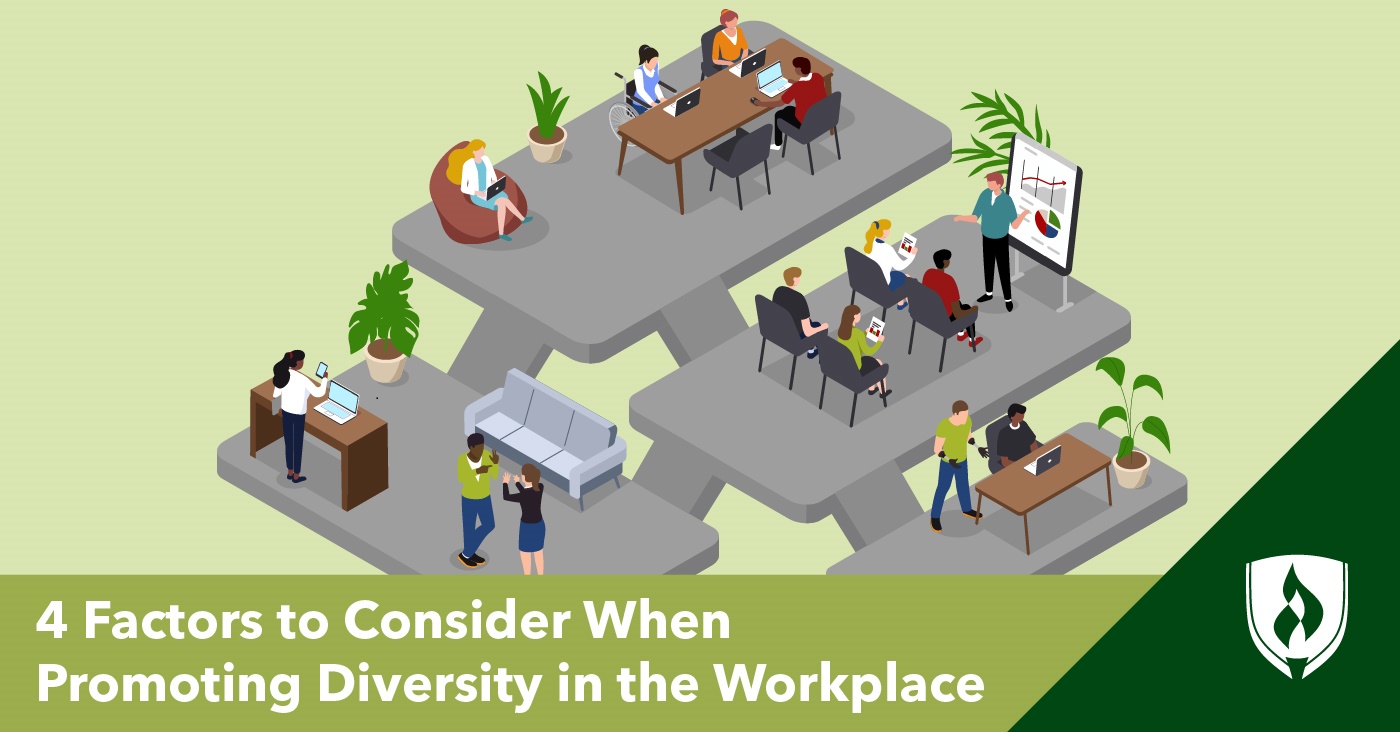
At the risk of understating it, 2020 was a year of incredible global change. The COVID-19 pandemic and its ramifications forced many people to rethink facets of their lives they may have previously never examined, including how they do their jobs and what they are willing to accept as normal. Additionally, the unrest sparked by the murder of George Floyd brought challenging, often raw conversations around racism, inequality and social justice to kitchen tables across America and the world.
Those important conversations didn’t just happen at the kitchen table—they also made their way into the board rooms of many organizations grappling with what to do in this moment. A Human Resources (HR) Policy Association membership survey found that 82 percent of respondents had diversity and inclusion efforts as a top issue for their organization—with 85 percent of respondents saying their organization has started the expansion of inclusiveness activities and increased C-suite involvement on the issue.1
Diversity, equity and inclusion (DEI) is clearly on the minds of organizational leadership, and human resources professionals play a key role in helping organizations navigate what can be a challenging subject. HR professionals influence recruiting, hiring and work to ensure that diversity-related efforts in the workplace don’t stop at performative gestures or isolated initiatives. While there’s no one-size-fits-all guide for how to approach creating a more diverse and equitable work environment, you can learn from others who’ve taken on this challenge—so read on to learn more.
4 Factors to consider for developing a diverse workplace
We asked experts to weigh in on why diversity at work is more important than ever and what organizations should keep in mind as they plan and implement DEI initiatives.
1. DEI efforts are everyone’s responsibility, not just HR.
Diversity, equity and inclusion (DEI) programs are well intentioned but often fall short of reaching their goals. One of the most common reasons that DEI efforts fail is due to a lack of buy-in from every tier of the organization. While it’s true that human resources professionals are responsible for recruiting and hiring diverse candidates, their ability to do so is severely hampered without enthusiastic support and championing from leadership.
Dr. Tanjia M. Coleman, HR expert and DEI consultant, says efforts to diversify the workplace can only be effective if everyone is on board.
“HR certainly can influence DEI efforts; however, the responsibility lies mainly with the CEO and C-suite. They set the tone for the culture and strategic priorities of the organization,” explains Dr. Coleman. “If the CEO doesn’t provide the framework for these initiatives, HR will face an uphill battle they may not win.”
Another common mistake made by HR representatives is attempting to develop and implement a strategic plan to increase diversity without actually being well versed in the subject. In this situation, Dr. Coleman stresses that it is crucial to reach out to DEI resources to help fill the gaps. “Companies have to be resolute, determined and consistent. This the only way that they will see sustainable traction and meaningful outcomes.”
Dr. Coleman states that DEI needs to be included in the organization’s missions, values and charter—and then reflected back on the community and other stakeholders.
2. Measurable results matter much more than rhetoric.
Just making a minimal effort to increase diversity or inclusion in the workplace isn’t going to cut it. A large segment of the public is growing tired of lip service and lofty words of support—they want to see results. That sentiment is carried over into the workplace as well.
If employees can’t see the results of a DEI program in their everyday jobs, you need to adjust your strategy or potentially scrap it and take a new approach. While you may be tempted to argue that any effort is better than none, a poorly planned or uninformed diversity initiative might actually alienate the people it was supposed to benefit. One study shows that, while 61 percent of all employees believe diversity and inclusion strategies are beneficial and essential, a whopping 75 percent of employees in underrepresented groups don’t feel they’ve personally benefited from their company’s programs.2
HR professionals and C-suite leadership can show their commitments to DEI by setting goals for their programs, measuring and evaluating initiatives, and pivoting accordingly when necessary.
3. A seat at the table isn’t enough.
Hiring employees with different backgrounds and life experiences is just the first step in creating a diverse and equitable company—and might actually be the easiest. It’s far more difficult to retain diverse employees once they actually try to integrate into the existing workplace culture.
Dr. Robin Rosenberg, clinical psychologist and consultant, shares that “Since George Floyd’s death, it became clearer than ever that a focus on diversity solely in an attempt to improve numbers doesn’t bring companies or employees where they want to be.” Dr. Eisenberg also posits that diverse candidates hired by companies that are trying to fill a quota are much less likely to stay because “they are apt to perceive that they were hired for their demographic identity, not necessarily for their skills, capabilities and perspectives. Inclusion without equity isn’t real inclusion.”
4. Workplace diversity benefits the entire organization.
Organizations that employee people of diverse genders, ages, religions, races, ethnicities, sexual orientations and cultural backgrounds reap many benefits—some of which you might not expect. Studies have shown:
- Companies with diverse leadership teams have greater profit margins and revenues as a result of increased innovation.3
- Cognitively diverse groups are able to solve problems faster than groups of cognitively similar people.4
- Diverse organizations enjoy higher engagement levels when employees feel included and valued.5
According to Janelle Owens, HR director at Test Prep Insight, increased diversity also correlates to a marked improvement in internal communication. She points out that “just about every company you've worked for during your life uses its own internal business jargon. This language often is very limited, generally because you have a group of homogeneous and like-minded employees.” In contrast, a diverse employee pool “creates a rich business vocabulary that not only permeates internal messages but also communication with customers who may not be privy to your company's terminology.” There is immense value in striving to communicate clearly and not assuming the other person thinks of everything the same way you do.
You can join the fight for diverse, inclusive and equitable workplaces
Human resources professionals are in a unique position to advocate for diverse, equitable and inclusive workplaces. In fact, some roles within HR are entirely dedicated to these issues. If you’d like to learn more about what a diversity-focused role in HR could look like, check out our article “The HR Professional’s Guide to Diversity and Inclusion Jobs.”
1HR Policy Association, “Survey Reveals Top Concerns of HR Executives in America” March 25, 2021 [accessed May 2021] https://www.hrpolicy.org/downloads/2021/03-24-21_PR_2021_CHRO_Survey.pdf
2Chris Georgas, Joe Gerstandt, Lisa D’Annolfo Levey and Marie Unger, “Diversity and Inclusion in the Workplace: What It Is, Why It Matters, and How to Make It a Priority” Quantum Workplace, September 2020. [accessed May 2021] https://www.quantumworkplace.com/diversity-and-inclusion-in-the-workplace
3Rocío Lorenzo, Nicole Voigt, Miki Tsusaka, Matt Krentz, and Katie Abouzahr, “How Diverse Leadership Teams Boost Innovation” Boston Consulting Group, January 23, 2018 [accessed May 2021] https://www.bcg.com/en-us/publications/2018/how-diverse-leadership-teams-boost-innovation
4Allison Reynolds and David Lewis, “Teams Solve Problems Faster When They’re More Cognitively Diverse” Harvard Business Review, March 30, 2017 [accessed May 2021] https://hbr.org/2017/03/teams-solve-problems-faster-when-theyre-more-cognitively-diverse
5Deloitte, “Waiter, is that inclusion in my soup? A new recipe to improve business performance” May 2013 [accessed May 2021]https://www2.deloitte.com/content/dam/Deloitte/au/Documents/human-capital/deloitte-au-hc-diversity-inclusion-soup-0513.pdf




